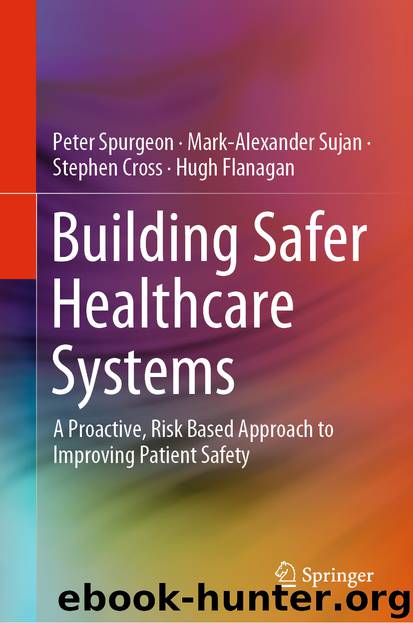Building Safer Healthcare Systems by Peter Spurgeon & Mark-Alexander Sujan & Stephen Cross & Hugh Flanagan

Author:Peter Spurgeon & Mark-Alexander Sujan & Stephen Cross & Hugh Flanagan
Language: eng
Format: epub
ISBN: 9783030182441
Publisher: Springer International Publishing
6.8 Tools and Techniques
In the Safer Clinical Systems programme, we carried out a depth of system analysis that is unusual in healthcare—though it is common in certain other safety-critical industries, and we drew heavily on those industries in designing the programme. Though several techniques were used, the most successful in highlighting risks to patients in this programme were Process Mapping, Hierarchical Task Analysis, and Failure Mode and Effects Analysis (Chap. 9 provides more information on the perceived utility of techniques and sources to identify risks to patients).
As outlined above, the thrust of these analyses is to map the elements of the system to a level of detail that enables risk to be identified and be localised, then to evaluate the strength of risk control measures and so come to a judgement about ‘residual’ or inadequately controlled risks to patients. Subsequent steps in the programme then address options for intervention.
We provide brief descriptions of the main tools and techniques below. An important element in them all, however, is the use of multidisciplinary groups. Constant themes in safety and quality improvement are the need to support communication outside of the ‘silos’ of individual professions such as nursing and medicine and the need to unlock and utilise the tacit knowledge of all staff involved in a system or pathway. A vital result of this process has been found to be the identification of risks to patients not previously recognised. A group—probably any group—of clinicians considering a system would be able to offer an immediate appreciation of the key risks to patients as they perceive them; in consensus-based, systematic analysis, however, ‘hidden’ risks, often significant, have been identified. But we believe it to be an essential element of Safer Clinical Systems in practice to ensure the full inclusion of all professions in the diagnosis of system safety. Detailed guides for these tools and techniques are available from many sources and have been collected in a reference guide developed by the Safer Clinical Systems support team (ref).
Download
This site does not store any files on its server. We only index and link to content provided by other sites. Please contact the content providers to delete copyright contents if any and email us, we'll remove relevant links or contents immediately.
| Automotive | Engineering |
| Transportation |
Whiskies Galore by Ian Buxton(41879)
Introduction to Aircraft Design (Cambridge Aerospace Series) by John P. Fielding(33064)
Small Unmanned Fixed-wing Aircraft Design by Andrew J. Keane Andras Sobester James P. Scanlan & András Sóbester & James P. Scanlan(32743)
Craft Beer for the Homebrewer by Michael Agnew(18140)
Turbulence by E. J. Noyes(7936)
The Complete Stick Figure Physics Tutorials by Allen Sarah(7307)
Kaplan MCAT General Chemistry Review by Kaplan(6867)
The Thirst by Nesbo Jo(6828)
Bad Blood by John Carreyrou(6552)
Modelling of Convective Heat and Mass Transfer in Rotating Flows by Igor V. Shevchuk(6391)
Learning SQL by Alan Beaulieu(6211)
Weapons of Math Destruction by Cathy O'Neil(6146)
Man-made Catastrophes and Risk Information Concealment by Dmitry Chernov & Didier Sornette(5921)
Digital Minimalism by Cal Newport;(5664)
Life 3.0: Being Human in the Age of Artificial Intelligence by Tegmark Max(5474)
iGen by Jean M. Twenge(5366)
Secrets of Antigravity Propulsion: Tesla, UFOs, and Classified Aerospace Technology by Ph.D. Paul A. Laviolette(5309)
Design of Trajectory Optimization Approach for Space Maneuver Vehicle Skip Entry Problems by Runqi Chai & Al Savvaris & Antonios Tsourdos & Senchun Chai(5011)
Pale Blue Dot by Carl Sagan(4912)
